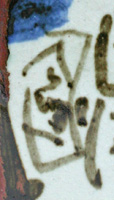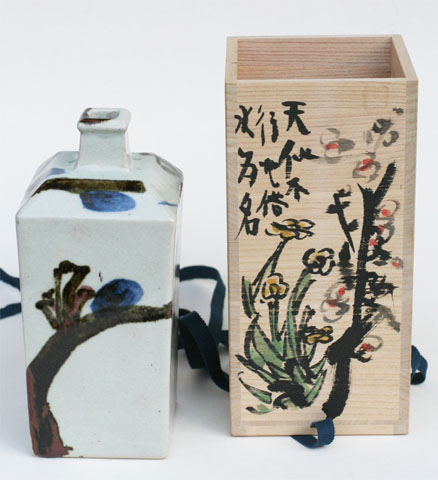Kyôyaki
Tetsue kakuzara, iron [oxide] decorated square vase - Haru mata kaeru, Spring returnsSigned: Kôshô
Seals:
Technique: Grey kyôyaki with an underglaze blue and brown iron oxide decoration 23,6 x 10,3 x 10,3
Box: Signed and extensively decorated
Condition: fine
From right to left:
- [“Water immortal” (paper-white)]. 天仙不行世借水為名: These “immortals” do not wander the world and use “the water” in their name, a paraphrase from the poem Daffodils by the Song poet Yang Wanli 1127-1206).
千紫萬紅 千客萬來: Senkôbanshi, senkyakubanrai: All the flowers bloom, thousands at the same time
- [Sanshi yû - Japanese cornel:] 山しゅうの一と枝ばかりの別火坊 A single branch of sanshi yû of the Bekkabô, a pavilion for a ceremony for monks on February 20-25
- [daffodil:] 春還歸。Haru mata kaeru. Spring returns.
Kôshô was born in Himeji. In 1927 he entered the Tôdai-ji in Nara. Upon graduating in Buddhist studies from Ryûkoku University in 1933, he took up residence at the Tenryû-ji for four years to study and practice Zen under the guidance of the Abbot Seki Seisetsu (1877-1945). In 1947 he became director of Tôdai -ji High School. In 1959 he was appointed director of the Monks' Academy (Kangakuin) at Tôdai-ji, and in 1963 became director of Tôdai-ji Girls' School and Tôdai -ji Kindergarten.
1969 marked a turning point in Kôshô's career, when he was appointed Head of Religious Affairs of the Kegon Tradition. In 1975 Kôshô was chosen to be the 207th abbot of Tôdai-ji, but he already resigned in 1981. For the remaining 18 years of his life, Shimizu Kôshô was a prolific “eccentric” painter, calligrapher and figurative potter.
Price: SOLD

